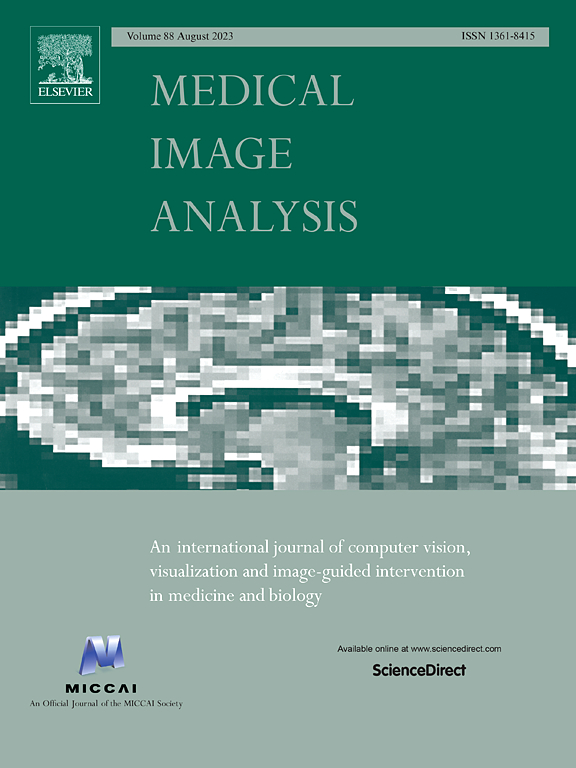ScanAhead: Simplifying standard plane acquisition of fetal head ultrasound
IF 11.8
1区 医学
Q1 COMPUTER SCIENCE, ARTIFICIAL INTELLIGENCE
引用次数: 0
Abstract
The fetal standard plane acquisition task aims to detect an Ultrasound (US) image characterized by specified anatomical landmarks and appearance for assessing fetal growth. However, in practice, due to variability in human operator skill and possible fetal motion, it can be challenging for a human operator to acquire a satisfactory standard plane. To support a human operator with this task, this paper first describes an approach to automatically predict the fetal head standard plane from a video segment approaching the standard plane. A transformer-based image predictor is proposed to produce a high-quality standard plane by understanding diverse scales of head anatomy within the US video frame. Because of the visual gap between the video frames and standard plane image, the predictor is equipped with an offset adaptor that performs domain adaption to translate the off-plane structures to the anatomies that would usually appear in a standard plane view. To enhance the anatomical details of the predicted US image, the approach is extended by utilizing a second modality, US probe movement, that provides 3D location information. Quantitative and qualitative studies conducted on two different head biometry planes demonstrate that the proposed US image predictor produces clinically plausible standard planes with superior performance to comparative published methods. The results of dual-modality solution show an improved visualization with enhanced anatomical details of the predicted US image. Clinical evaluations are also conducted to demonstrate the consistency between the predicted echo textures and the expected echo patterns seen in a typical real standard plane, which indicates its clinical feasibility for improving the standard plane acquisition process.
ScanAhead:简化胎儿头部超声的标准平面采集
胎儿标准平面采集任务旨在检测具有特定解剖标志和外观特征的超声图像,以评估胎儿生长。然而,在实践中,由于人类操作员技能的变化和可能的胎儿运动,对于人类操作员来说,获得一个满意的标准平面是具有挑战性的。为了支持人类操作员完成这项任务,本文首先描述了一种从接近标准平面的视频片段中自动预测胎儿头部标准平面的方法。提出了一种基于变压器的图像预测器,通过理解美国视频帧内头部解剖的不同尺度来产生高质量的标准平面。由于视频帧和标准平面图像之间的视觉差距,预测器配备了一个偏移适配器,该适配器执行域自适应,将平面外结构转换为通常出现在标准平面视图中的解剖结构。为了增强预测的US图像的解剖细节,该方法通过利用第二种方式进行扩展,US探针运动,提供3D位置信息。在两种不同的头部生物测量平面上进行的定量和定性研究表明,所提出的美国图像预测器产生临床可信的标准平面,其性能优于已发表的比较方法。双模态解决方案的结果显示,随着预测的US图像的解剖细节增强,可视化得到改善。通过临床评价,验证了预测的回波纹理与典型真实标准平面的预期回波模式的一致性,表明了改进标准平面采集过程的临床可行性。
本文章由计算机程序翻译,如有差异,请以英文原文为准。
求助全文
约1分钟内获得全文
求助全文
来源期刊

Medical image analysis
工程技术-工程:生物医学
CiteScore
22.10
自引率
6.40%
发文量
309
审稿时长
6.6 months
期刊介绍:
Medical Image Analysis serves as a platform for sharing new research findings in the realm of medical and biological image analysis, with a focus on applications of computer vision, virtual reality, and robotics to biomedical imaging challenges. The journal prioritizes the publication of high-quality, original papers contributing to the fundamental science of processing, analyzing, and utilizing medical and biological images. It welcomes approaches utilizing biomedical image datasets across all spatial scales, from molecular/cellular imaging to tissue/organ imaging.
 求助内容:
求助内容: 应助结果提醒方式:
应助结果提醒方式:


